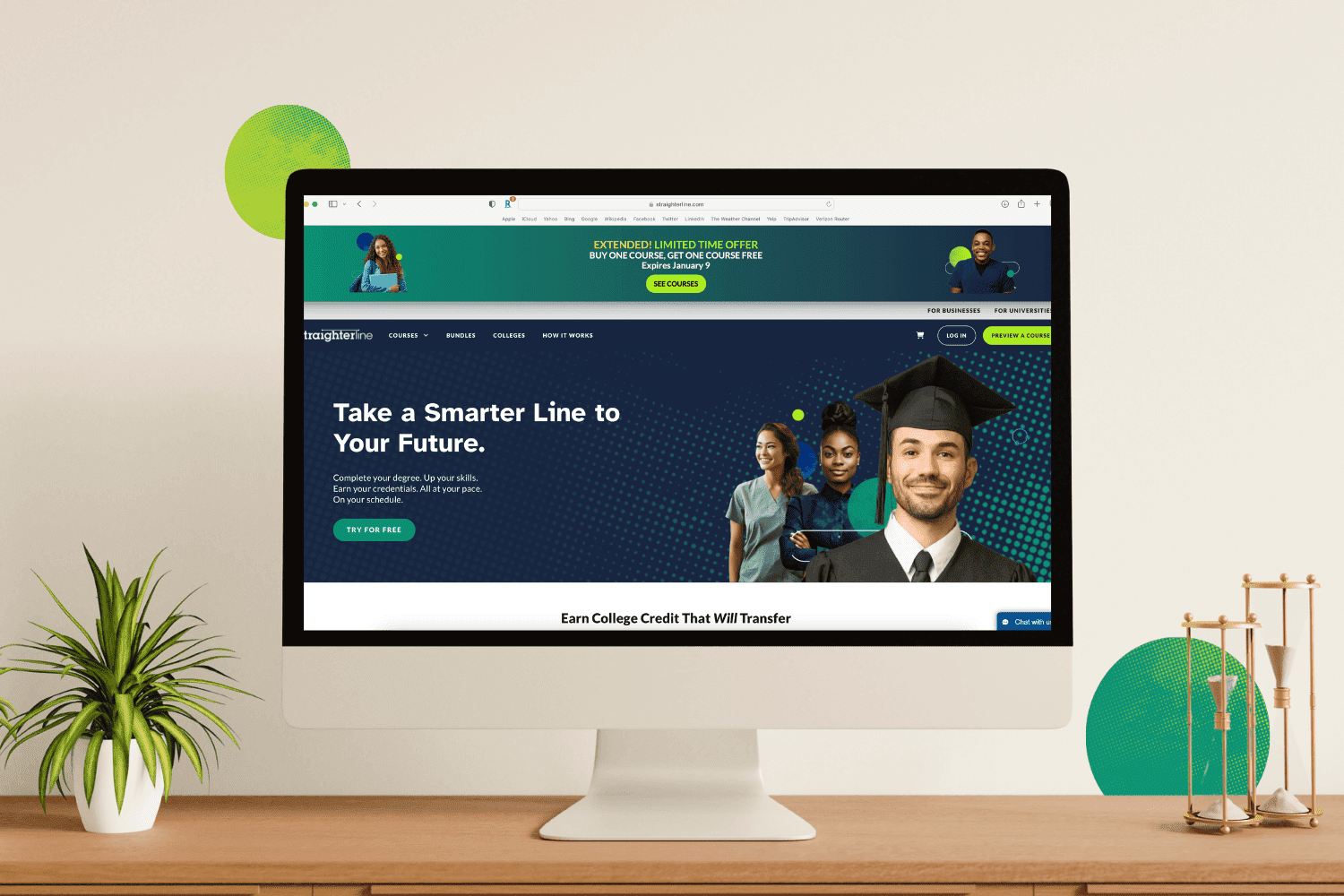The rise of online learning has revolutionized the way students approach their education, offering unparalleled flexibility and accessibility. However, one of the most pressing questions for prospective online students is: Are online prerequisite courses accepted by colleges? Acceptance of online PreReqs depends on several factors, such as accreditation, credit transferability, and institutional policies.
In this guide, we’ll explore everything you need to know to ensure your online prerequisite courses, such as ones you can take through StraighterLine, will be recognized by your colleges. From understanding the factors that affect credit acceptance to verifying transferability, we’ll help you navigate the complexities of online education.
Do Colleges Accept Online Prerequisite Courses?
The short answer is yes — many colleges accept online prerequisite courses, but it depends on specific factors like accreditation, course content, and alignment with institutional requirements. As online learning grows in popularity, colleges have become more open to accepting credits earned online. However, not all online courses are created equal, and ensuring acceptance requires careful planning.
Common Scenarios Where Online Courses Are Accepted
General education prerequisites like Math, English, or Biology.
Courses completed through pre-approved online platforms like StraighterLine or community colleges with online offerings.
Advanced Placement (AP) or dual enrollment courses completed online.
When Online Courses May Be Rejected
Courses from unapproved providers.
Programs without sufficient rigor or alignment with institutional standards.
Non-transferable credits due to differences in course content or credit hour requirements.
Factors That Affect Credit Acceptance for Online Prerequisite Courses
1. Accreditation of the Institution or Provider
Accreditation is the most critical factor when determining if an online course will be accepted. Colleges typically require credits to come from regionally or nationally accredited institutions. Accreditation ensures the course meets academic standards and quality benchmarks.
Regional Accreditation: Most widely recognized by colleges and universities. Examples include Middle States, WASC, and SACS.
National Accreditation: Often accepted by technical or vocational schools but less transferable to traditional colleges.
Program-Specific Accreditation: Fields like nursing or engineering may have additional accreditation requirements.
*Please note: Accreditation is reserved for degree-granting institutions, which StraighterLine is not. However, StraighterLine courses are reviewed and recommended for credit by the American Council on Education (ACE)—a key requirement for most colleges and universities that accept outside credit. StraighterLine credits have successfully transferred to over 3,000 institutions.
2. Course Content and Rigor
The course syllabus and content must align with the college’s requirements. For example:
A prerequisite biology course for a nursing program may need to cover specific lab work or human anatomy topics.
Institutions may request course descriptions or syllabi to evaluate equivalency.
3. Credit Hour Compatibility
Courses must meet the credit hour requirements set by the college. For instance, a 3-credit course on one platform might not transfer if the target institution requires 4 credits for the equivalent course.
4. Credit Transfer Policies
Each institution has its own credit transfer policies. These policies outline:
The maximum number of transferable credits.
Specific course requirements for majors.
Restrictions on the type of institutions (e.g., only regionally accredited schools).
5. Timing of Course Completion
Some colleges have time limits for accepting prerequisite courses, especially in rapidly evolving fields like technology or healthcare. For example, a biology course completed 10 years ago may not be valid for a current program.
Ensuring Courses Are Accredited and Meet Transfer Requirements
To maximize the chances of your online prerequisite courses being accepted, follow these key steps:
1. Choose an Approved Institution or Platform
Always verify that the course provider is accredited by a recognized accrediting body. Platforms like StraighterLine and community colleges often meet these requirements. For example, StraighterLine courses are reviewed and approved for credit transfer by the American Council on Education (ACE). ACE is the organization many colleges and universities refer to when determining whether to accept transfer credit. Use the U.S. Department of Education Database or CHEA to check accreditation status.
2. Match Course Content to Target College Requirements
Obtain the syllabus or course description from the online course provider.
Compare it with the course requirements listed in your target college’s catalog.
Look for equivalencies in topics covered, credit hours, and learning objectives.
3. Review Credit Transfer Policies
Most colleges have a transfer credit policy page on their website. Review this information to understand:
The types of courses they accept.
Any restrictions or limitations.
Specific documentation needed for evaluation.
4. Focus on General Education Courses
General education courses like English, College Algebra, and Introductory Sciences are more likely to be accepted because they are standard across many institutions. Specialized or advanced courses may require additional evaluation.
5. Consult Academic Advisors
Academic advisors at both the online course provider and your college can offer valuable insights. They can confirm:
Whether the course fulfills prerequisite requirements.
Any additional steps you need to take for transfer approval.
How to Verify Transferability with Target Institutions
Even if you’ve selected an approved provider and ensured course alignment, you’ll need to verify that the credits will transfer. Here’s how:
1. Contact Your School’s Admissions Office
The admissions office or transfer services department at your target institution is the best resource for credit transfer questions. Provide them with:
The name of the course and provider.
The course syllabus and description.
Any accreditation information.
2. Use Transfer Equivalency Tools
Many colleges offer online tools to check transfer equivalencies. Examples include:
Transferology: A nationwide tool for checking credit transferability.
College-specific tools: Many universities list equivalent courses from partner institutions. StraighterLine has 180+ partner schools, and each school has a Course Equivalency Guide to help students transferring credits see which courses they can take.
3. Request a Pre-Approval Letter
Some colleges allow you to request pre-approval for a course before you enroll. This guarantees the course will fulfill the required prerequisite if completed successfully.
4. Submit Official Transcripts
Once the course is completed, send an official transcript from the online provider to your target college. Ensure it includes:
The institution’s name.
Accreditation details (if applicable).
Course title and grade.
5. Follow Up with Academic Departments
For specialized courses, consult the specific academic department (e.g., the biology or nursing department) to verify if the course meets program-specific requirements.
FAQs About Online Prerequisite Courses and Credit Acceptance
Do all colleges accept online prerequisite courses? Not all colleges accept online credits; It depends on factors like accreditation and alignment with course requirements.
How can I ensure my online courses are transferable? Choose approved providers, verify course alignment, and consult with your college or university before enrolling.
Can I transfer online prerequisite courses to Ivy League schools? Ivy League institutions often have stricter policies. Pre-approval and rigorous course content are usually required. Even so, Harvard is among the 3,000 schools that have accepted credit from StraighterLine courses.
Do online courses count for lab-based prerequisites? Some colleges require in-person labs. Look for hybrid courses that include hands-on components.
What if my online course is not accepted? If a course is not accepted, you may need to retake it at an approved institution.
Top Platforms Offering Transferable Online Prerequisite Courses
To streamline your search, here are some platforms known for offering transferable online prerequisite courses:
1. StraighterLine
ACE-recommended, widely recognized, and accepted by 3,000 colleges and universities.
Offers flexible, self-paced online courses.
Focused on general education and prerequisite topics.
2. Community College Online Programs
Affordable and regionally accredited.
Often have transfer agreements with four-year institutions.
3. ACE-Recommended Courses
Look for courses evaluated by the American Council on Education (ACE), as they are frequently transferable.
StraighterLine Helps You Plan Ahead for Success
Online prerequisite courses are a valuable and flexible way to meet academic requirements, but ensuring their acceptance requires careful planning. By choosing approved providers, aligning courses with your college’s requirements, and verifying transferability upfront, you can confidently take the next steps in your educational journey.
Take control of your education today — start by exploring our courses and see how you can make getting your degree more flexible, and save thousands on tuition.












